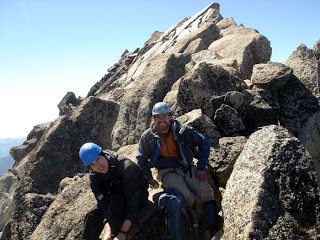More than the daily dose of adventure
The jungle always adds to an adventure. It's something about heat and humidity mixed with thick vegetation and unknown sub-tropical creatures - a combination that turns a simple day of hiking and climbing into a noteworthy mission. Yesterday the goal was a newly developed crag at Pha Tang mountain 25 km north of Vang Vieng, the the central region of Laos PDR. Myriad factors led to this day of motorbiking and climbing being quite different from a day at the local rock gym.
First, and possibly least, is the gact that this region of Laos is ethnically Hmong. Hmong fighters, hold-outs from the Vietnam War, former American allies, and still clinging to the possibilty of autonomy, have been clashing with Laos military police as recently 2005. In 2003 a tourist bus and some German bicyclists were caught in the crossfire. My fears were mediated after careful research (finding no recent reports of incidents) and seeing no signs of armament while travelling this Highway 13 last week from Luang Prubang. None-the-less motorscootering on rough roads through the poorest of villages in a former war-zone breeds apprehension. So after a hour of riding through this picturesque karst countryside I was mometarily relieved when we arrived at a simple quarry that would safely park our bikes (story has it that our gas would be siphoned if left in teh woods).
The spider trail ended at a fence and we retraced our steps to the stream and crossed it. We then gained a wide shallow river which we waded easily without our shoes. I did not know it at the time but I think this is where I got the leech bite on my foot that later in the day would not stop bleeding. We easily crossed a patchwork of rice paddies and came to the side of a small hut which I think is used in the rainy season for the farmers. Now just a few hundred meters seperated us from the limestone though an unkept orchard retaken by jungle stood in our way - there were faint trails but nothing seemed continuous. I was cautious to leave well-trodden ground as in my research I also learned of the hundreds of thousands of land mines placed unmapped by the Viet Cong. My nervousness was surely over-zealous and unfounded due to my poor understanding of Laos geography and post-war reparations. I was lacking an objective way to understand these risks (as I would, say, of the possibility of an avalanche) and though it was extremely unlikely we were to come across a unexploded ordinance I was mentally tired apon reaching th base of the enormous limestone massif.
The wall stood tall, dusty, and covered with cobwebs. Bamboo leaned into it and created a quintissential jungle atmosphere. Josie, always strong, made short work of one named climb and then quickly located two others that we had no information of. They seemed very new and we cleaned bugs and dirt and loose rock as we climbed. The 5.11 climbing itself was technical and steep and followed an impressive brown dike through the harder gray limetsone. We climbed 30 meter picthes at eth ground - there was clearly another 300 meter of stone above us. I am now reminded that apon reaching this second set of climbs we encountered a very bizzarre bat trap that was essentialy just a fishing net hung up perpendicular to the cliff between two bamboo poles. We had to get very close to the net before understanding what it was, but as we near the three near-death bats wringled in their unfortunate situation and stared at us in something I can only describe as fear. the whole scene was quite unnerving and added to the mental game that we were already playing with the dirty rock before us.
After our fill of jungle rock we worked back through the jungle and across the river. We were very hungry from the day because we got what we thought was sticky rice wrapped in bamboo leaves - turns out we unwrapped pandora's banana leaves to find what was I think about a tablespoon of uncooked pork. To shorten the already lengthy story: we reached the bikes just as it began to drizzle, we were starving , and the mixed clay and concrete road was quickly becoming trenchorous as it wetted. We had no choice to stop for chicken part and rice noodle soup in the first small village and sit with nice Laos people, only pointing and smiling, as the rain past. We returned to Vang Vieng just as the sun was setting into the bright orange of late evening. I had had my daily dose of adventure - and I think maybe a little extra for good measure.
Photos: 1) The sun sets. The view from my bungalow. 2)Crossing the leech stream and heading towards the tower. 3)Bat in net. Quite possibliy the freakiest thing I have ever seen - sorry but just had to give you nightmares too 3)If the bat wasn't enough this is the spider that almost punctured Josie's eyeball.









